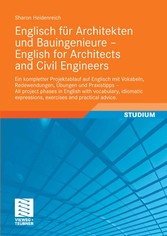
Englisch für Architekten und Bauingenieure - English for Architects and Civil Engineers
von: Sharon Heidenreich
Vieweg+Teubner (GWV), 2008
ISBN: 9783834894762
Sprache: Englisch
201 Seiten, Download: 3788 KB
Format: PDF, auch als Online-Lesen
Mehr zum Inhalt

Englisch für Architekten und Bauingenieure - English for Architects and Civil Engineers
2 Preliminary Enquiries (S. 15-16)
2.1 Feasibility
Before the architect gets too involved in the project, a decision has to be made as to whether it is at all feasible to build. Feasible means possible as well as practicable and is influenced by a number of factors. For example, the decision may depend on the access to the site, building lines and specific requirements regarding the number of storeys, parking provisions and, of course, geological conditions. The decision to proceed or to stop lies with the client, however, it is the architect’s task to present the information in a structured way so that it is possible for the client to come to a decision.
2.1.1 Planning authorities
In order to judge the feasibility of a project, the architect or civil engineer should consult the local planning authority. Planning authorities have a wealth of information and will be able to advise on development plans, conservation areas, listed buildings and trees with preservation orders. Local planning authorities will also have a view on the acceptability of the proposed development. It is possible to submit an outline application to determine the likelihood of a proposal being accepted, this is especially useful for more daring designs and costly projects.
Frequently state or local authorities draw up development plans for specific areas. The intention of development plans is to balance business, residential and community needs and, at the same time, protect areas from the adverse effects of development. Development plans influence the scale, location and timing of land development and redevelopment. Therefore the starting point for the local planning authority in considering any planning application will be the development plan. Any provisions in it relating to the specific site, area or type of proposed development will affect the scheme. The local planning authority will also be able to provide a water table, information on the liability to flooding and information on the nature of the subsoil. Furthermore, they will be able to indicate the position and depths of all main services.
2.1.2 Feasibility study
In order to prepare a feasibility study the architect needs to check various aspects of the site. Some questions will be quite straightforward, however, others may require input from a consultant or might have to be based on assumptions, at least before making a detailed survey. In the following, there are some typical considerations that an architect will make before putting together a feasibility study.
- Is the site appropriate for the client’s proposed scheme?
- How does the topography suit the scheme?
- Does the size of the plot seem reasonable for the scale of the project?
- What is the nature of the soil?







